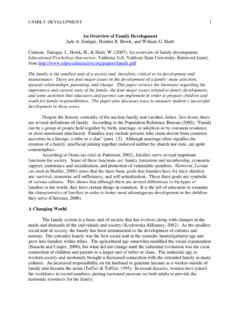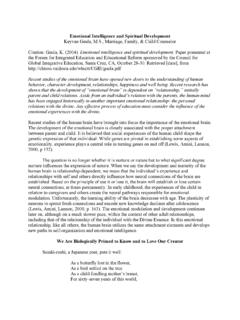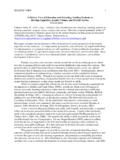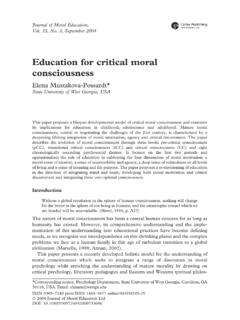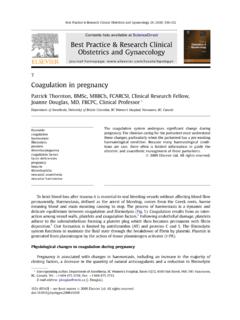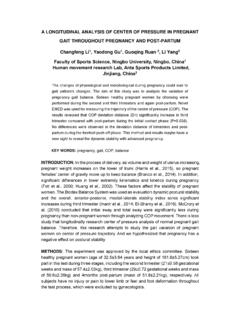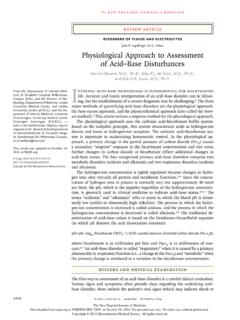Transcription of Affective Domain 1 - Abnl
1 Affective Domain 1 Overview of the Affective Domain Amy M. Brett, Melissa L. Smith, Edward A. Price, & William G. Huitt Citation: Brett, A., Smith, M., Price, E., & Huitt, W. (2003). Overview of the Affective Domain . Educational Psychology Interactive. Valdosta, GA: Valdosta State University. Retrieved [date], from Mounting evidence supports the position that human beings are inherently emotional beings and that emotion and Affective development impacts human development and behavior in a wide variety of important ways. This paper provides an overview of emotion and the Affective Domain , including developmental considerations and methods that can be used to facilitate development in this Domain .
2 Also discussed are instruments and methods to assessment emotional and Affective development. Life in America at the dawning of the 21st century exhibits a complex tapestry of distressful social and cultural problems, including public school and church shootings, racial and ethnic tensions, apathy and cynicism in the political sphere, grave challenges to the family unit, and disturbing levels of youth violence, drug abuse, alcoholism, and teen pregnancy. All of these problems have an important feature in common they are heavily influenced and, in some cases, dominated by the power of human emotions (Goleman, 1995; Greenspan, 1997; LeDoux, 1996). Most psychologists agree that the study of emotion and the Affective Domain is one of the most perplexing topics in the field of psychology (Plutchik, 2001).
3 However, even the somewhat confusing picture produced to date has led researchers to conclude that one s emotional awareness and ability to manage emotions may be even more important than IQ in determining success and contentment throughout all areas of life (Gardner, 1995; Sternberg, Wagner, Williams & Horvath, 1995). A variety of definitions have been provided for emotion and its relation to the Affective Domain . Aristotle gave one of the earliest when he described emotions as all those feelings that so change [people] as to affect their judgments, and that are also attended by pain or pleasure (Jenkins, Oatley & Stein, 1998; p. 7). However, Plutchik (2001) estimated that more than 90 different definitions of emotion were proposed throughout the 20th century.
4 One of the most well-known was provided by Goleman (1995) who defined emotion as, a feeling and its distinctive thoughts, psychological and biological states, and range of propensities to act (p. 289). The Affective Domain refers to emotions as well as their outward expression. As with the concept of emotion, descriptions of the Affective Domain are rather vague, lacking a universal, operationalized definition. While emotion is at the core of the Affective Domain , it spreads quickly from there. This is because emotion is often seen as involving three subcomponents: feeling, cognition, and behavior. Feeling is the physiological sensation one experiences. Cognition is the subjective thoughts that accompany the sensation.
5 Behavior, which might be facial display, body positioning, or a variety of other actions, is related to both feelings and accompanying cognitions. Thus, the Affective Domain encompasses physiological, cognitive, and behavioral processes related to emotion. It also encompasses our awareness or discernment of our and other s emotions, the ability to connect our emotions to those of others, the display of emotion, and the ability to manage or regulate one s emotions. Affective Domain 2 While the Affective Domain has been a subject of research for centuries, there are three individuals who are typically considered the founding fathers of research on emotions: Charles Darwin (1998), William James (1884), and Sigmund Freud (1960).
6 Darwin founded his concept of ethology with observations of emotional expression in natural settings and connected them to human evolution. James emphasized physiological changes in the body and showed that emotions are involved in monitoring our bodies. Freud offered the method of listening to what people said about their emotional lives and people may need to discuss their emotions with others in order to be understood. More recently the concept of appraisal has become an important influence on research in the Affective Domain . Theories of Emotion As with any concept, researchers and theorists have differing views as to the function and importance of the Affective Domain .
7 Some see it as a regulatory system whereas others see it as an activation system. Some see emotion as a precipitating event whereas others see it as a resulting event. This section will discuss some of the current theories and models. In the Communicative Theory (Oatley & Johnson-Laird, 1995), emotions are viewed as caused by conscious or unconscious cognitive evaluations. Each evaluation produces a signal that is transmitted through multiple processors of cognitive architecture to produce a basic emotion. This signal functions to control organization of the brain in order to ready the mechanisms of action and bodily resources, to direct attention, to set up biases of cognitive processing, and to make the issue the caused the emotions salient in consciousness.
8 The phenomenological experience of the signal is a distinctive feeling, or emotion ( happiness, sadness, anger, etc.). Thus, in essence, emotions are seen as managing goals. The Feedback Theory (Parkinson & Manstead, 1992) assumes that emotions arise as a consequence of a bodily reaction, rather than cognitive appraisals of a presenting situation. This theory dates to William James (1884), who drew attention to the fact the bodily responses, including facial, postural, motor, and autonomic changes, are central aspects to our idea of experiencing emotion. Our relationship with an object evoking the emotion is expressed through the body ( , turn away from unpleasant sights, approach pleasant sights).
9 Thus, part of experiencing emotion is to feel oneself expressing a physical attitude toward an object. Furthermore, James proposed that feelings are a result, rather than cause of emotional behavior ( , we are happy because we smile). A similar theory, the Discrete Emotion Theory (Fogel, Nwokah, Dedo, Messinger, Dickson, Matusov, and Hold, 1992) suggests that emotions organize and motivate action such that a discrete emotion can be defined as a particular set of neural processes that lead to a specific expression and a corresponding specific feeling. The emotion program is believed to be phylogenetically adapted with respect to the basic function of survival. This theory breaks down each emotion, suggesting that patterns of neural stimulation cause associated changes in feeling, and are associated with distinct sets of facial, vocal, respiratory, skin, and muscle responses.
10 These theorists focus primarily on the face in expression of emotion, and believe emotional development is controlled by maturation of the central nervous system (CNS), and that the organism must learn rules that modify and modulate expression. An example of research that supports this position had participants hold a pencil between their teeth for a period of time, a task that uses the facial muscles involved with smiling. Results showed that the participants reported feeling happy. Affective Domain 3 According to the Functionalist Model (Campos, Mumme, Kermoian, & Campos, 1994), emotion is the attempt by the person to establish, maintain, change, or terminate the relation between the person and the environment on matters of significance to the person (p.)


